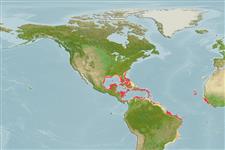Common names from other countries
>
Anguilliformes (Eels and morays) >
Muraenidae (Moray eels) > Muraeninae
Etymology: Gymnothorax: Greek, gymnos = naked + Greek, thorax, -akos = breast (Ref. 45335).
More on author: Kaup.
Environment: milieu / climate zone / depth range / distribution range
Écologie
marin récifal; profondeur 0 - 60 m (Ref. 9710), usually 0 - 35 m (Ref. 40849). Subtropical; 41°N - 26°S, 99°W - 5°W
Western Atlantic: Bermuda and southern Florida, USA to the Antilles (Ref. 26340) and southeast Brazil (Ref. 42064). Eastern Atlantic: St. Paul's Rocks (Ref. 13121), Cape Verde, Ascension and St. Helena islands (Ref. 4450). Also mid-Atlantic islands (Ref. 26938).
Taille / Poids / Âge
Maturity: Lm ? range ? - ? cm
Max length : 70.0 cm TL mâle / non sexé; (Ref. 4450); common length : 40.0 cm TL mâle / non sexé; (Ref. 5217)
Description synthétique
Morphologie | Morphométrie
Dark brown with numerous yellow dots, smallest on head and largest toward end of tail where they are irregular and confluent (Ref. 13442). Stout moray with a short blunt snout. Tip of tail always pale, usually deep yellow in life. Posterior nostril in short tube (Ref. 26938).
A benthic and solitary species (Ref. 26340) inhabiting coral reefs and rocky shorelines. Usually at depths of 60 m (Ref. 26938). One of the most common and easily recognized morays of the West Indian reefs, active during the day and sometimes hunting together with other predators (Ref. 42064). This species has been called Muraena miliaris (Ref. 26938).
Life cycle and mating behavior
Maturité | Reproduction | Frai | Œufs | Fécondité | Larves
Robins, C.R., R.M. Bailey, C.E. Bond, J.R. Brooker, E.A. Lachner, R.N. Lea and W.B. Scott, 1991. Common and scientific names of fishes from the United States and Canada. Am. Fish. Soc. Spec. Publ. (20):183 p. (Ref. 3814)
Statut dans la liste rouge de l'IUCN (Ref. 130435)
CITES (Ref. 128078)
Not Evaluated
Menace pour l'homme
Harmless
Utilisations par l'homme
Pêcheries: intérêt commercial mineur; Aquarium: Commercial
Plus d'informations
Taille/ÂgeCroissanceLongueur-poidsLongueur-longueurFréquences de longueursMorphométrieMorphologieLarvesDynamique des populations larvairesRecrutementAbondance
RéférencesAquacultureProfil d'aquacultureSouchesGénétiqueElectrophoresesHéritabilitéPathologiesTraitementMass conversion
Outils
Articles particuliers
Télécharger en XML
Sources Internet
Estimates based on models
Preferred temperature (Ref.
115969): 24.6 - 28, mean 27 (based on 498 cells).
Phylogenetic diversity index (Ref.
82804): PD
50 = 0.5000 [Uniqueness, from 0.5 = low to 2.0 = high].
Bayesian length-weight: a=0.00098 (0.00061 - 0.00158), b=3.24 (3.11 - 3.37), in cm Total Length, based on LWR estimates for this species & Genus-body shape (Ref.
93245).
Niveau trophique (Ref.
69278): 3.9 ±0.63 se; based on food items.
Résilience (Ref.
120179): Milieu, temps minimum de doublement de population : 1,4 à 4,4 années (Preliminary K or Fecundity.).
Fishing Vulnerability (Ref.
59153): Moderate to high vulnerability (48 of 100).
